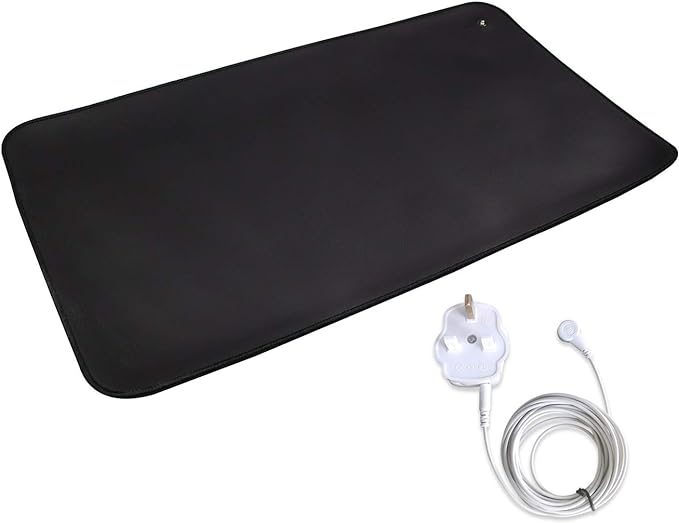Biohacking – where the pursuit of optimal wellness intersects with cutting-edge science, the topic of earthing mats often emerges. A critical inquiry in this field is: what are earthing mats made of? These mats, integral to the practice of grounding, have garnered significant attention for their potential health implications.
In this article, we will discuss the composition of earthing mats. Revealing the different materials that facilitate our connection to the earth’s subtle electrical charge. Aimed at both experienced biohackers and newcomers, this piece seeks to understand earthing mats and their potential to optimize health.
What is grounding?
In grounding, we reconnect our bodies with the Earth’s natural electric charge, a principle at the core of this practice. Consider the Earth as a vast reservoir of negative electrical potential. A baseline against which our modern lifestyle often disrupts our body’s natural electrical state.
In the context of biohacking, we understand grounding as a method to rebalance this electrical state. The human body, with its network of electrical activities, are essential for cellular and systemic functions. These can accumulate a positive electrical charge over time, primarily due to environmental factors, e.g. electromagnetic fields from devices and the insulating effect of modern footwear and housing.
To practice grounding, one makes direct physical contact with the Earth’s surface. Through barefoot walks on grass, sand, or soil or even touching natural bodies of water. This contact facilitates the transfer of negatively charged electrons from the Earth into the body. This transfer hypothetically neutralizes the accumulated positive charge, effectively rebalancing the body’s electrical state.
Scientifically, experts consider this process as contributing to the reduction of inflammation. The negatively charged electrons from grounding may neutralize positively charged and inflammatory free radicals. Furthermore, grounding is believed to enhance sleep, reduce stress, and improve circulatory health.
It’s important to note that while grounding is a practice with historical roots and anecdotal support. Its scientific backing is an area of ongoing research in the field of biohacking and wellness. Thus, grounding is seen not just as a return to an ancestral state of living in closer harmony. But also as a potential means of countering some of the imbalances introduced by the modern, insulated lifestyle.
Is grounding based on science or is it woo-woo?
Grounding, or earthing, sits intriguingly at the crossroads of science and what some might label as “woo-woo”. The concept of grounding reconnects us with the Earth’s natural electric charge and straddles the line between scientific hypothesis and yet-to-be-fully-proven health claims.
On the scientific side, grounding is based on the principle that the Earth maintains a negative electric charge. In theory, when one makes direct contact with the Earth’s surface, the body can absorb these negative electrons. Hypotheses suggest that this process neutralizes free radicals – unstable molecules damaging cells and contributing to inflammation and disease. Although research is limited some grounding studies have found improved sleep, reduction in inflammation and stress, increased parasympathetic nervous system activation,
However, here’s where the “woo-woo” whispers begin. Despite these promising findings, grounding research is still in its infancy, with many studies having limitations like small sample sizes or lack of peer review. The scientific community calls for more rigorous, comprehensive research to conclusively establish the health benefits of grounding. Until such evidence is robust, grounding will likely continue to dance on the fine line between accepted science and alternative wellness.
In essence, grounding is a practice with a scientific basis that is yet to be fully embraced by the scientific community. It’s a blend of a potentially valid bioelectrical interaction and a wellness practice that many find beneficial. Even if all the reasons aren’t yet scientifically illuminated. Like many emerging health trends, grounding is a patchwork of proven concepts, anecdotal evidence, and areas awaiting further exploration.
What are earthing mats made of?
Earthing mats are designed with a focus on functionality and conductivity. Their primary purpose is to replicate the electrical grounding effect that one would naturally receive from direct contact with the Earth’s surface.
An earthing mat’s design centers around its conductive layer, typically made from carbon or carbonized rubber. Designers choose these materials for their electron-conducting efficiency, reflecting the Earth’s natural conductivity. Manufacturers often integrate the conductive element into a durable fabric, creating a mat that is practical for regular use and effective in transferring the Earth’s electrons to the user.
To establish a grounding effect, these mats include a connecting cord that links them to an earth grounding port. You typically make this connection either through a standard electrical outlet with a grounding pin or by placing a grounding rod directly in the soil. This connection is crucial as it facilitates the transfer of the Earth’s electrons from the ground, through the mat, and into the body of the user.
When a person comes into contact with the surface of the earthing mat, usually with bare skin, a conductive pathway is established. This pathway allows the free flow of electrons from the Earth to the body, simulating the electrical exchange that occurs during barefoot contact with the Earth’s natural terrains like grass, soil, or sand.
In essence, earthing mats are a testament to the principle of returning to our natural, electrically grounded state, especially important in an age where lifestyle and environmental factors often disrupt our natural electrical balance. These mats are a straightforward yet scientifically grounded tool in the biohacker’s toolkit, designed to bridge the gap between our modern indoor lifestyles and the Earth’s natural electric field.
How to use earthing mats
Using an earthing mat is a straightforward process, yet it requires a thoughtful approach to maximize its benefits. Here’s a guide to using an earthing mat effectively:
Placement of the Mat
First, determine a suitable location for your earthing mat. Common choices include areas where you spend significant time, such as beneath your desk, near your workstation, or beside your bed. The key is to place the mat in a location where you can maintain consistent physical contact with it, ideally with bare skin.
Setting Up the Connection
Ensure that your earthing mat is properly grounded. Most mats come with a grounding cord that can be connected to a grounded electrical outlet. If your living space doesn’t have grounded outlets, you may need to use a grounding rod system, which involves placing a rod in the soil outside and running a wire to your mat.
Direct Contact
For the earthing mat to be effective, direct contact with your skin is essential. You can achieve this by placing your bare feet or hands on the mat while sitting or working. Some people prefer to use the mat while sleeping, placing it on their mattress and making contact with any part of their bare skin.
Duration of Use
Consistency and duration are key. The more time you spend in contact with the earthing mat, the more you may benefit from the grounding process. Many users report improvements in sleep quality and reductions in stress and inflammation after extended use.
Maintenance
Keep your earthing mat clean and functional. Follow the manufacturer’s instructions for cleaning to maintain its conductivity. Regular checks for wear and tear are also advisable to ensure it remains effective.
Monitor Your Experience
As with any biohacking tool, individual experiences can vary. Pay attention to how your body responds to the use of the earthing mat. Some users report immediate effects, while for others, the benefits may become noticeable over time.
Remember…
Remember, while earthing mats are a tool to help simulate the experience of direct earth contact, they are not a substitute for actual physical connection with natural environments. Whenever possible, complement the use of an earthing mat with activities that involve direct contact with nature, such as walking barefoot on grass or soil.
Benefits of earthing mats
- Reduced Inflammation: By facilitating the transfer of negative electrons from the earth, earthing mats may help neutralize free radicals, potentially leading to decreased inflammation in the body.
- Improved Sleep: Users have reported enhanced sleep quality with regular use of earthing mats, possibly due to the stabilization of the body’s natural electrical environment.
- Enhanced Circulation: Earthing may improve blood flow and circulation, contributing to better oxygenation and nutrient delivery throughout the body.
- Stress Reduction: Users have reported enhanced sleep quality with regular use of earthing mats, possibly due to the stabilization of the body’s natural electrical environment.
- Pain Relief: Some individuals experience relief from chronic pain, likely related to the anti-inflammatory effects of earthing.
- Increased Energy: Regular grounding can contribute to a general feeling of increased vitality and well-being, possibly as a result of improved sleep and reduced stress.
- Boosted Immune Function: By potentially reducing inflammation and stress, earthing mats might indirectly support a healthier immune system.
It’s important to note that while many users report these benefits, experiences can vary, and the scientific understanding of earthing is still evolving. We encourage users to incorporate earthing as part of a holistic approach to health and wellness.
Recommended products
Earthing mats provide a practical solution for reconnecting with the earth’s natural energy. Below, we have curated a couple of high-quality earthing mats, each chosen for its proven effectiveness and material integrity. Designers have created these products to facilitate a consistent grounding practice in your daily routine. Explore our recommendations to find an earthing mat that aligns with your health and wellness goals.


